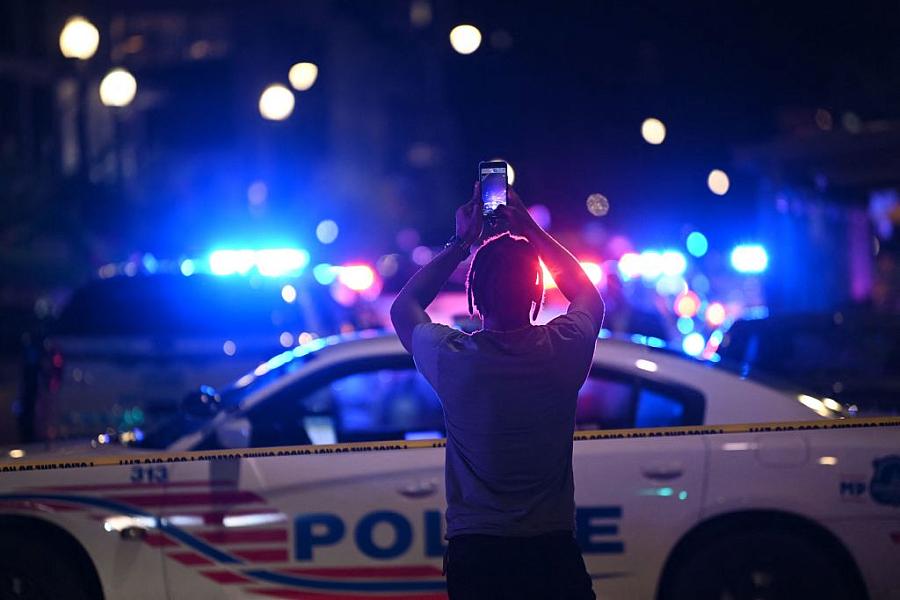Overpolicing erodes communities, yet the research on new strategies is mixed

(Photo by Brendan Smialowski/AFP via Getty Images)
In communities of color across the country, aggressive overpolicing is eroding the health of residents who live in a constant state of fear. Some worry about a possible bad encounter with law enforcement, while others live with the traumatic memories of already having experienced one.
This kind of policing environment, often targeted at people who have done nothing illegal, is leading to chronic stress that puts wear and tear on the body over time, said Hedwig Lee, co-director of the Center for the Study of Race, Ethnicity and Equity at Washington University in St. Louis, during a presentation to journalists taking part in the Center for Health Journalism’s 2021 National Fellowship via Zoom this week.
To deal with it all, residents often become hypervigilant and adopt coping mechanisms that may further endanger their health, such as driving the short distance to the corner store rather than walking to avoid a run-in with police, or overeating or drinking. Mothers worry constantly about their sons, afraid they may lose their lives at the hands of those meant to protect them.
The evidence shows they may have good reason for concern. Lee has found in her research that Black men and boys face the highest lifetime risk of being killed by police. One in 1,000 will be killed by police over the life course, compared to one in 2,500 white men. They are also more likely to be surveilled or stopped and frisked, Lee said.
“This frequent surveillance and unnecessary criminalization of Black and brown communities by officers are forms of racism and they have lots of consequences for population health equity,” she said.
The killing of George Floyd during a police stop in Minneapolis last year brought new attention to the issue and a renewed focus on police reform efforts, both federally and in several state legislatures. Andrea Headley, assistant professor at the McCourt School of Public Policy at Georgetown University and a visiting scholar of policing, race and crime at the National Police Foundation, joined Lee to discuss overpolicing and how reform efforts could either make neighborhoods better for marginalized communities or further entrench age-old problems, depending on how they are implemented.
Headley told the journalists policing should move beyond traditional punitive strategies, and address social issues that lead people to commit crimes, such as poverty, racism and mental health and substance abuse issues.
“We do know that some strategies, particularly when thinking about policing or incarceration, might be effective in reducing crime … but they have really disastrous side effects,” Headley said. “Particularly when we are thinking about some of the tradeoffs that impact people’s livelihoods or their health and well-being.”
Research has found that some policing strategies such as community policing and implicit bias training have had mixed results and have not significantly changed the culture in police departments, Headley said. Community policing efforts have been shown to shine a positive light on the perception of a department, but have had limited impact on crime outcomes, she said. Implicit bias training can improve the knowledge of officers, but there is no evidence it reduces policing disparities.
One bright spot is what happens when departments hire more women and people of color, Headley said. Women have been found to be less forceful and exhibit behavior that is less controlling than men, in favor of more supportive strategies, Headley said. Some research has shown that when there are more officers of color, there are fewer stops and arrests, although that does not erase the fact that some officers of color brutalize people as well.
Research has found that some policing strategies such as community policing and implicit bias training have had mixed results and have not significantly changed the culture in police departments, Headley said.
Other intervention programs that work outside of police departments or in partnership with them — typically with a health-centered focus — have shown promise in reducing crime, both Headley and Lee said. Violence intervention programs, such as Ceasefire, which use outreach workers to mediate conflict, can reduce gang violence, and hospital-based intervention programs have also been shown to reduce some violence.
Investment in community and social supports, such as nonprofits focused on building stronger communities, can also reduce violence. So can improving access to mental health care officers and substance abuse programs. A mobile crisis intervention program in Oregon’s Eugene-Springfield metro region called CAHOOTS also has potential for other areas, Headley said. There, a team of a medical professional such as a nurse or an EMT accompanies a crisis worker with several years experience in the mental health field when responding to calls about those suffering a psychological crisis or other mental health incident.
Even as these new programs are being deployed in an attempt to reinvent policing, Headley said the danger is repeating old disparities through new methods.
“The questions I think need to be asked are whether or not racism and disparate outcomes are being produced in new forms or new ways that we’re just not uncovering yet,” Headley said. “If other forms of contact with social workers or mental health counselors are also not productive or are also having harms on people, we need to find ways to document that and be able to explore why that is happening.”
Journalists can also play a role as the watchdogs of such reforms.
“There are lots of reforms being proposed but we don’t know much about how they actually impact disparities and racism … and so it is important to try to unpack, and it is a huge missing piece from a research perspective, but also from a storytelling perspective,” Headley said.
Andrea K. McDaniels is a former Center for Health Journalism Fellow who is now freelancing after leaving her job at The Baltimore Sun after more than 20 years.

